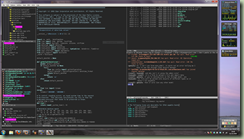>Windows 7 / Emacs / Ubuntu
>
The Dell is back in Windows land, with Windows 7 installed. I’m using it with the setup I detailed here and everything works as expected.
A word about Emacs. I spent quite a bit of time over the last couple of months sorting out the mish mash of different emacs configs I had running. Now there is one config which handles everything I want it to. Whereas before I used to keep the configs in svn, this time I am using Dropbox to share the configs between Ubuntu, Windows and Mac and the .emacs (currently 211 lines long) works perfectly between all three. So when I add a keybinding or piece of emacs code into one they appear on all four machines. Losing version control doesn’t bother me so much, I rarely want to look back through versions – having everything applied immediately is much more useful.
The Ubuntu VM’s I am using on the Windows machine have Dropbox linked through the vmware shared folders. With my current setup I can create a fully working Ubuntu 8.04 environment with all my emacs customisations in less than five minutes.
If you expand that picture you’ll see it’s using ECB mode – something which I used for a few years but stopped using some time ago when I had some issues with it. Starting from the top left and going down and then across we have.
1. ECB Directories window
2. ECB Current directory window
3. ECB Methods and variables browser (showing items for the DateTime.py file)
4. ECB History Window (files recently visited)
5. DateTime.py (something I am actually editing!). Although it’s not switched on here I have flymode on which is linked to various utilities that can display PEP8 infringements or syntax errors inline.
6. DIRED view of a directory I am working in.
7. irc (#django channel on freenode)
8. Editing the hosts file. This is actually in sudo mode, using tramp. Means I can go sudo and edit a file without starting another terminal up.
The Dell’s 1920×1080 resolution makes this worthwhile. I can reboot this machine into Mandriva and have the same development environment straight away. Or switch to the Mac, Ubuntu desktop or even Ubuntu Netbook and have it all working exactly the same. Very nice.

3 thoughts on “>Windows 7 / Emacs / Ubuntu”
>Dropbox can restore an old version.
>Can't view your screenshot without a Yahoo login. I hate Yahoo 🙁
>I just wanted to comment your blog and say that I really enjoyed reading your blog post here. It was very informative and I also digg the way you write! Keep it up and I'll be back to read more soon mate